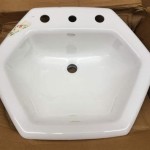Bathroom Sink Measurements: A Comprehensive Guide
The bathroom sink, a seemingly simple fixture, plays a crucial role in creating a functional and aesthetically pleasing bathroom space. Choosing the right sink involves careful consideration of its measurements, as these directly impact the overall layout, usability, and visual appeal of the bathroom. This guide provides a comprehensive overview of bathroom sink measurements, covering essential factors to consider when selecting the perfect sink for your needs.
Understanding Sink Dimensions
Bathroom sinks come in various sizes and shapes, each with unique dimensions that influence its suitability for different bathroom configurations. The key dimensions to consider are:
- Width: The width of the sink, measured from side to side, determines the amount of countertop space available for accessories or toiletries.
- Depth: The depth of the sink, measured from front to back, affects the basin's capacity and overall functionality.
- Height: The height of the sink, measured from the countertop to the top of the basin, influences accessibility and comfort.
- Bowl Size: The size of the basin, including its diameter and depth, determines the amount of space available for washing hands and face.
- Overall Length: This measurement captures the total length of the sink, including the basin and any additional features like a faucet deck.
It is essential to understand these measurements to ensure the chosen sink fits comfortably within the available space and accommodates your desired functionality.
Choosing the Right Sink Size
Selecting the appropriate sink size depends on the specific needs of your bathroom and personal preferences. Consider the following factors:
Space Considerations
The available space in your bathroom directly influences the maximum size of the sink you can accommodate. Measure the countertop area where the sink will be installed, factoring in any surrounding cabinets or fixtures. Ensure sufficient space remains for comfortable movement and access.
Functionality
If you need ample space for washing hands and face, opt for a wider and deeper sink. For smaller bathrooms or limited space, a compact sink with a smaller bowl size might be more suitable.
Aesthetics
The desired aesthetic of your bathroom also plays a role in choosing the sink size. A large, statement sink can create a dramatic focal point, while a smaller, minimalist sink might blend seamlessly with the overall design. Consider the overall style of the bathroom and select a sink that complements the existing fixtures and decor.
Standard Sink Sizes
While sink dimensions can vary widely, certain standard sizes are commonly available. Understanding these standard sizes can help compare different options and make an informed decision.
Standard Sink Widths
Common sink widths include 18", 21", 24", 27", and 30". Smaller sinks, like 18" or 21", are ideal for compact bathrooms or powder rooms, while wider sinks, such as 27" or 30", provide ample space for larger bathrooms or families.
Standard Sink Depths
Typical sink depths range from 6" to 10". A shallower depth might be easier to reach, while a deeper depth offers greater capacity and allows for more water to be contained in the basin.
Standard Sink Heights
The standard height for bathroom sinks is typically around 34" from the floor, considering the countertop thickness. This height ensures comfortable accessibility for most individuals. However, consider adjusting the sink height based on personal preferences or accessibility needs.
Remember that these are just general guidelines, and actual sink dimensions may vary depending on the manufacturer and specific model. Always consult the manufacturer's specifications for accurate measurements before purchasing.
Tips for Measuring Your Bathroom Sink
Precise measurements are crucial for ensuring the chosen sink fits perfectly in your bathroom. When measuring your bathroom sink space, follow these steps:
- Clear the Area: Remove any existing sink, countertop, or surrounding fixtures that might obstruct the measurement process.
- Measure the Countertop: Measure the length and width of the countertop area where the sink will be installed. Ensure that the sink dimensions fit comfortably within the available space.
- Consider Faucet Placement: Measure the distance from the edge of the countertop to the desired faucet location. This will help determine the required sink length and ensure ample space for the faucet and accessories.
- Account for Undercounter Space: Ensure that the chosen sink fits within the available undercounter space. Check the sink's depth and make sure it aligns with the depth of the countertop and cabinet.
- Consider Overall Layout: Visualize the overall layout of the bathroom, including the sink, toilet, and shower. Make sure the sink dimensions allow for ample space for comfortable movement and access.
By carefully measuring the space and considering all relevant factors, you can ensure that the chosen sink fits perfectly and enhances the functionality and aesthetic appeal of your bathroom.

What S The Standard Depth Of A Bathroom Vanity

Plan Your Bathroom By The Most Suitable Dimensions Guide Engineering Discoveries Small Sinks Sink Vanity

Ruvati 16 In X 11 Undermount Bathroom Sink Brushed Stainless Steel Rvh6107 The Home Depot

American Standard Size Sanitary Ware Bathroom Sink White Wash Basin Solid Surface Washing Vanity China Art Made In Com
How To Measure A Vanity Sink Bathroom Dimensions Standard Size Vevano

Bathroom And Restroom Measurements Standards Guide
How To Measure For A Bathroom Basin Or Sink Victoriaplum Com

Vessel Sink Bathroom Vanity Counter Top Sizes

Basin Sizes Toilet Shower Enclosure Bathroom Dimensions Durovin

B604 Rectangular Undermount Vanity Sink Bristol Sinks
Related Posts







